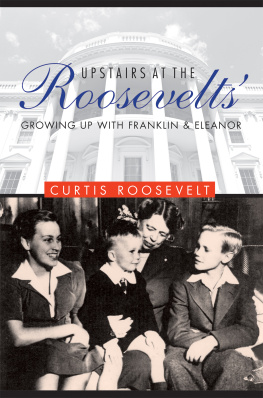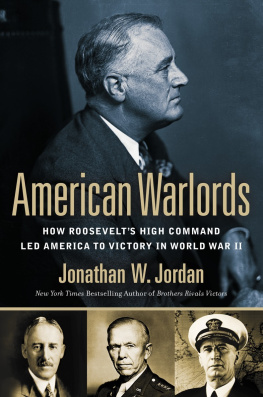The Sailor
The Sailor
Franklin D. Roosevelt and the Transformation of American Foreign Policy
David F. Schmitz
Copyright 2021 by The University Press of Kentucky
Scholarly publisher for the Commonwealth, serving Bellarmine University, Berea College, Centre College of Kentucky, Eastern Kentucky University, The Filson Historical Society, Georgetown College, Kentucky Historical Society, Kentucky State University, Morehead State University, Murray State University, Northern Kentucky University, Transylvania University, University of Kentucky, University of Louisville, and Western Kentucky University.
All rights reserved.
Editorial and Sales Offices: The University Press of Kentucky
663 South Limestone Street, Lexington, Kentucky 40508-4008
www.kentuckypress.com
Library of Congress Cataloging-in-Publication Data
Names: Schmitz, David F., author.
Title: The sailor : Franklin D. Roosevelt and the transformation of American foreign policy / David F. Schmitz.
Other titles: Franklin D. Roosevelt and the transformation of American foreign policy
Description: Lexington, Kentucky : University Press of Kentucky, [2021] | Series: Studies in conflict, diplomacy, and peace | Includes bibliographical references and index.
Identifiers: LCCN 2020053146 | ISBN 9780813180441 (hardcover) | ISBN 9780813180465 (pdf) | ISBN 9780813180458 (epub)
Subjects: LCSH: United StatesForeign relations19331945. | Roosevelt, Franklin D. (Franklin Delano), 18821945. | United StatesPolitics and government19331945. | World War, 19391945United States. | InternationalismHistory20th century. | Lend-lease operations (19411945)
Classification: LCC E806 .S3488 2021 | DDC 973.917092dc23
This book is printed on acid-free paper meeting the requirements of the American National Standard for Permanence in Paper for Printed Library Materials.
Manufactured in the United States of America.
To Polly
Who enhances it all
Contents
Preface
The postWorld War II world was shaped more by Franklin D. Roosevelt than anyone else. The Roosevelt world was created in response to the dual crises of the Great Depression and World War II. The internationalist policies Franklin Roosevelt pursued in response to the upheavals of the 1930s and 1940s set off a great debate about the role of the United States in the world from the mid-1930s through the war years. Roosevelt saw the proper role of the United States as a world leader with its power and influence extended globally, basing its defense on preparedness and collective security, and cooperating with allies through multilateral international organizations to promote and protect American values and institutions. In FDRs vision of a postwar world, peace, prosperity, and American security would be obtained through the Good Neighbor Policy, the Atlantic Charter, and the four freedoms that emerged from the challenges posed by fascism and militarism in the 1930s and which guided the fighting of World War II.
Franklin Roosevelt saw World War II as one war with many parts. He was the only person in the position to confront all aspects and theaters of the war and to have the knowledge and ability to engage each of the vexing international issues. He understood how the complex political, military, and strategic problems were interrelated, and what was needed to secure a stable, peaceful, and prosperous world order. His great design1 was pursued in a manner to avoid the mistakes of the Treaty of Versailles. The maintenance of the alliance with Great Britain after World War II was critical but not sufficient to achieve the goals of postwar peace and prosperity. That would take the continuation of the Grand Alliance with the Soviet Union, the rebuilding of Germany and Japan, the establishment of multilateral international economic institutions, and an end to colonial empires.
As Arthur M. Schlesinger Jr. noted in 1994, the contrast between Roosevelt and the other leaders during World War II was stark. The world we live in today is Franklin Roosevelts world, Schlesinger wrote. It was not the world of Adolf Hitler, whose thousand-year Reich turned out to have a brief and bloody run of a dozen years, or the world of Joseph Stalin that had just recently collapsed with the end of the Soviet Union. Nor was it the one envisioned by Winston Churchill that maintained Europes empires.2 Roosevelt was determined to do all he could to eliminate any chance of a revival of fascist militarism and set the course for international economic cooperation to prevent future wars. The president understood that Russia was crucial for winning the war and would emerge as a great power; the only way to peace was by engaging it as a partner in the postwar world. Finally, FDR foresaw the end of Europes colonial empires and that China would also emerge as a great power. He, therefore, sought a Third Way between imperialism and revolution to bring forward a pro-Western nationalism.
This work is an interpretive analysis of Franklin Roosevelts overall approach to and the making of American foreign policy. Its purpose is to explain FDRs worldview, his beliefs about the United States and its interests, the presidents understanding of the issues that confronted America, and how these shaped the policies he developed to address the crises of the 1930s and the Second World War. Given the significance of Roosevelts diplomacy, it is surprising that there is only a single, one-volume study of the entirety of FDRs foreign policy, Robert Dalleks Franklin D. Roosevelt and American Foreign Policy, 19321945.3 While still valuable in its encyclopedic treatment of Roosevelts diplomacy, it is dated due to the availability of new sources and a significant volume of scholarship on various aspects of Roosevelts foreign policy over the forty years since its publication. It also sets out the prevailing view that Roosevelt was an isolationist who became, due to pressures outside the Western Hemisphere, a reluctant interventionist in world affairs.4 By extension, most scholars have seen little continuity in Roosevelts thinking or coherence in his approach to the world. Thus, most works concentrate on either the 1930s or the World War II years. This study challenges these assumptions.
Introduction
Sailor
As with sailing, so with politics: make your cloth too taut and your ship will dip and heel, but slacken off and trim your sails, and things head up again.
Euripides, Orestes
In 1916, Assistant Secretary of the Navy Franklin D. Roosevelt was on the destroyer USS Flusser off the coast of Maine conducting an inspection of American naval ships. Sailing near Campobello Island, where the Roosevelt family spent most summers, the review was interrupted when a heavy fog, common to the area, set in. Familiar with the local waters and conditions, Roosevelt took command of the vessel from Lieutenant William F. Bull Halsey Jr. and steered the ship through Lubec Narrows, the straight between Campobello and the mainland. Roosevelt had sailed many smaller boats in these difficult waters, but he had never commanded a destroyer. Halsey was naturally concerned about the fate of his ship: The fact that a white-flannelled yachtsman can sail a catboat out to a buoy and back is not guarantee that he can handle a high-speed destroyer in narrow waters. A destroyers bow may point directly down the channel, yet she is not necessarily on a safe course. She pivots around a point near her bridge structure, which means that two-thirds of her length is aft of the pivot, and that her stern will swing in twice the arc of her bow. As Mr. Roosevelt made his first turn, I saw him look aft and check the swing of our stern. My worries were over; he knew his business.1












